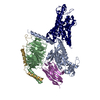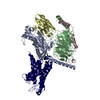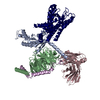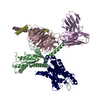+Search query
-Structure paper
| Title | Structural basis of adhesion GPCR GPR110 activation by stalk peptide and G-proteins coupling. |
|---|---|
| Journal, issue, pages | Nat Commun, Vol. 13, Issue 1, Page 5513, Year 2022 |
| Publish date | Sep 20, 2022 |
 Authors Authors | Xinyan Zhu / Yu Qian / Xiaowan Li / Zhenmei Xu / Ruixue Xia / Na Wang / Jiale Liang / Han Yin / Anqi Zhang / Changyou Guo / Guangfu Wang / Yuanzheng He /  |
| PubMed Abstract | Adhesion G protein-coupled receptors (aGPCRs) are keys of many physiological events and attractive targets for various diseases. aGPCRs are also known to be capable of self-activation via an ...Adhesion G protein-coupled receptors (aGPCRs) are keys of many physiological events and attractive targets for various diseases. aGPCRs are also known to be capable of self-activation via an autoproteolysis process that removes the inhibitory GAIN domain on the extracellular side of receptor and releases a stalk peptide to bind and activate the transmembrane side of receptor. However, the detailed mechanism of aGPCR activation remains elusive. Here, we report the cryo-electron microscopy structures of GPR110 (ADGRF1), a member of aGPCR, in complex with G, G, G, G and G The structures reveal distinctive ligand engaging model and activation conformations of GPR110. The structures also unveil the rarely explored GPCR/G and GPCR/G engagements. A comparison of G, G, G, G and G engagements with GPR110 reveals details of G-protein engagement, including a dividing point at the far end of the alpha helix 5 (αH5) of Gα subunit that separates G/G engagements from G/G/G engagements. This is also where G/G bind the receptor through both hydrophobic and polar interaction, while G/G/G engage receptor mainly through hydrophobic interaction. We further provide physiological evidence of GPR110 activation via stalk peptide. Taken together, our study fills the missing information of GPCR/G-protein engagement and provides a framework for understanding aGPCR activation and GPR110 signaling. |
 External links External links |  Nat Commun / Nat Commun /  PubMed:36127364 / PubMed:36127364 /  PubMed Central PubMed Central |
| Methods | EM (single particle) |
| Resolution | 2.83 - 3.09 Å |
| Structure data | EMDB-32881, PDB-7wxu: EMDB-32882, PDB-7wxw: EMDB-32883, PDB-7wy0: EMDB-32905, PDB-7wz7: EMDB-32972, PDB-7x2v: |
| Source |
|
 Keywords Keywords |  MEMBRANE PROTEIN / MEMBRANE PROTEIN /  GPCR GPCR |
 Movie
Movie Controller
Controller Structure viewers
Structure viewers About Yorodumi Papers
About Yorodumi Papers















